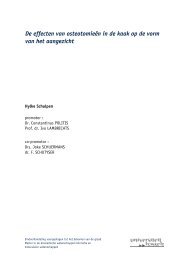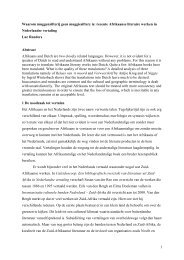Planning Problems in Intermodal Freight Transport ...
Planning Problems in Intermodal Freight Transport ...
Planning Problems in Intermodal Freight Transport ...
Create successful ePaper yourself
Turn your PDF publications into a flip-book with our unique Google optimized e-Paper software.
sufficient number of conta<strong>in</strong>er pools. The authors do not <strong>in</strong>tegrate loaded and empty conta<strong>in</strong>er<br />
flow decisions <strong>in</strong> a s<strong>in</strong>gle model. L<strong>in</strong> and Cheng [47] study a network design problem of a<br />
door-to-door express service. An air-ground <strong>in</strong>termodal carrier provides a delivery service <strong>in</strong> a<br />
hierarchical hub-and-spoke network. The network consists of multiple clusters. Local cluster<br />
centres are connected to their own hub through a secondary route. Each hub is connected to<br />
other hubs through a primary route. Large trucks or aircrafts are used on primary routes,<br />
smaller trucks or aircrafts on secondary routes. The problem is to determ<strong>in</strong>e fleet size, routes<br />
and schedules for both primary and secondary trucks or aircrafts simultaneously, with the<br />
objective to m<strong>in</strong>imize the sum of fixed and operat<strong>in</strong>g costs while meet<strong>in</strong>g the desired service<br />
level. The authors formulate the problem as an <strong>in</strong>teger program <strong>in</strong> a route-space directed<br />
network. The b<strong>in</strong>ary program is solved through an implicit enumeration algorithm that<br />
conta<strong>in</strong>s an embedded least time path sub-problem.<br />
F<strong>in</strong>ally, pric<strong>in</strong>g strategy decisions have to be considered at the tactical plann<strong>in</strong>g level.<br />
Li and Tayur [48] develop a tactical plann<strong>in</strong>g model for <strong>in</strong>termodal rail transport that jo<strong>in</strong>tly<br />
considers operations plann<strong>in</strong>g and pric<strong>in</strong>g decisions. In the operations-plann<strong>in</strong>g subproblem,<br />
freight rout<strong>in</strong>g, tra<strong>in</strong> rout<strong>in</strong>g and tra<strong>in</strong> assignment are considered simultaneously. Tra<strong>in</strong> routes,<br />
frequency of service and number of locomotives and flatcars used on each route need to be<br />
determ<strong>in</strong>ed. The comb<strong>in</strong>ed problem is formulated as a nonl<strong>in</strong>ear programm<strong>in</strong>g model. It is<br />
solved to optimality through a decomposition that exploits the structure of the subproblems.<br />
The model is developed for the <strong>in</strong>termodal transport of trailers, but may be easily extended to<br />
<strong>in</strong>termodal transport of conta<strong>in</strong>ers. Two other papers on pric<strong>in</strong>g strategy decisions are given<br />
by Yan et al. [49] and Tsai et al. [50]. Yan et al. [49] develop a framework for estimat<strong>in</strong>g the<br />
opportunity costs for all services <strong>in</strong> trailer-on-flatcar operations. These opportunity costs are<br />
to be taken <strong>in</strong>to account when sett<strong>in</strong>g the price level of <strong>in</strong>termodal transport. The framework









